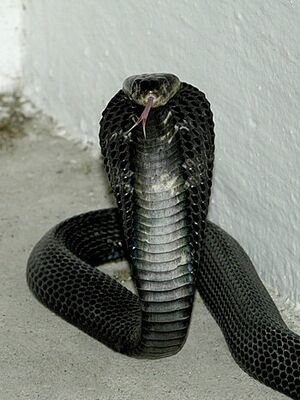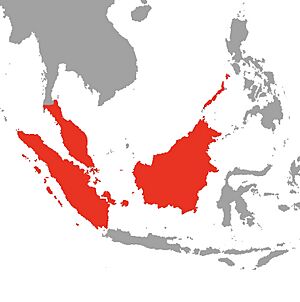Equatorial spitting cobra facts for kids
Quick facts for kids Equatorial spitting cobra |
|
|---|---|
 |
|
| Conservation status | |
| Scientific classification | |
| Genus: |
Naja
|
| Species: |
sumatrana
|
 |
|
The Equatorial spitting cobra (Naja sumatrana) is a fascinating snake. It's also known by other names. These include the Malayan, golden, Sumatran, or Palawan spitting cobra. This snake is a type of spitting cobra. You can find it in Southeast Asia.
Contents
What Does the Equatorial Spitting Cobra Look Like?
This cobra is a medium-sized snake. It usually grows to be about 0.9 to 1.2 meters (3 to 4 feet) long. Some can even reach up to 1.5 meters (5 feet). Its body is a bit flat from top to bottom. The back part is more rounded.
The cobra's head is oval-shaped. It's a little flatter than its body. The head is also slightly wider than its neck. It has a short, rounded snout and big nostrils. Its eyes are medium-sized with round pupils. The scales on its back are smooth. They are also slanted.
This cobra does not have special markings on its hood. Its color changes depending on where it lives. There are two main color types. One is yellow. You often see this type in Thailand. It's also common in Northern Peninsular Malaysia. The other type is black. This one is found in Peninsular Malaysia and Singapore. It also lives on islands in Indonesia and the Philippines. Young cobras and adult cobras can have different colors too.
Scales on the Cobra's Body
The scales around the cobra's hood usually number between 21 and 25 rows. Just before the middle of its body, there are 15 to 19 rows. It has 179 to 201 scales on its belly. The scales under its tail range from 40 to 57. The first few scales under the tail are often not divided.
Where Do These Cobras Live?
You can find this cobra in countries near the equator. These are in Southeast Asia. They live in Brunei, Indonesia, Malaysia, Singapore, and Thailand. They are also found in the Philippines.
In Indonesia, they live on islands like Sumatra and Borneo. They are also on Bangka, Belitung, and the Riau Archipelago. They might live on other nearby islands in Indonesia. It's also possible that some still live in western Java. In the Philippines, they only live on the Palawan group of islands. This includes the Calamian Islands.
Where Do They Live and What Do They Eat?
These cobras can live in places up to about 1500 meters (about 4900 feet) above sea level. They mostly live in tropical forests. This includes thick jungle areas. But you can also find them in gardens and parks. Sometimes, they even show up in cities. This means they might meet humans.
The Equatorial spitting cobra lives on the ground. It is active mostly during the day. It mainly eats rodents like mice and rats. It also eats frogs. But it will also eat other snakes, lizards, and small mammals.
These snakes are not usually very aggressive. But if they feel trapped or threatened, they will spit venom. They can even spit venom from up in trees. They will also strike and bite if they need to defend themselves.
Understanding the Cobra's Venom
Like other cobra species, this snake has venom that affects nerves. This is called a neurotoxin. The venom also contains substances that affect the heart (cardiotoxins) and cells (cytotoxins).
The venom of the Equatorial spitting cobra is special. It has different proteins than other spitting cobras found in the same areas. These include the Javan spitting cobra and the Indochinese spitting cobra.
The venom of this cobra has low levels of some enzymes. But it has high levels of other enzymes. For example, it has a lot of phospholipase A2. Substances called cardiotoxins make up 40% of this snake's venom protein. This is a higher amount than in other cobras in the same region. For example, the Javan spitting cobra has 35% cardiotoxins. The Indochinese spitting cobra has 30%.


